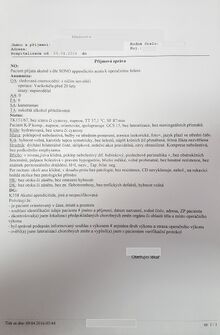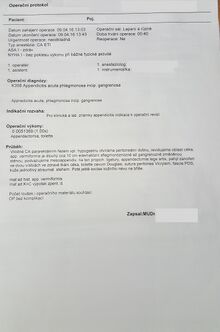Documentation in surgery
Documentation is a set of information describing the patient's condition, diagnosis, treatment and personal information. It accompanies each patient throughout their stay in the hospital, i.e. from admission to discharge. Documentation in surgery is very similar to documentation in non-surgical fields. The main difference is in the extended documentation during the surgical procedure, which contains complete information about the performed procedure, anesthesia and recommended follow-up care.
Surgical documentation contains many sections, each section containing different information, such as instructions on aftercare. The individual parts of the documentation are: medical record, income report, decursion, physiological sheet, acute card, consultation - internal, informed consent, operating protocol, anesthesia record and analgesic sheet.
Documentation[edit | edit source]
Medical Record[edit | edit source]
The medical record is the basic medical documentation of a patient in a hospital. Contains:
- A − employment number, personal information: social security number, first and last name, department, permanent residence, zip code, insurance company, ID number, employment, contact for relatives.
- B – admitting doctor, treating doctor, date and time of admission, onset of symptoms, diagnosis on admission, other diseases.
Decurs[edit | edit source]
Dekurz is a patient medical record that records the patient's daily condition and treatment progress. It contains basic information about the patient: diagnosis, epicrisis and care plan, allergies , difficulties, planned examinations and diet. An important part of the course is medical therapy, which includes drugs for the given day, type, amount and dosage, anticoagulation therapy , ATB . Data for nursing staff - monitoring of pressure and pulse, pupil, saturation , temperature. Information about rehabilitation and movement regime.
Income Report[edit | edit source]
Every patient must have an income report before being admitted to the department. It contains more detailed information about the patient, which is described by the doctor during the outpatient examination. Includes medical history and diagnosis on admission.
- NO : For what reason the patient is admitted, a brief description of the course of the disease until arrival at the ambulance, e.g. a patient admitted with acute appendicitis after 24 hours of pain in the right hypogastrium.
- History : OA, AA, FA, SA, TA.
- Status : Description of the patient's condition: pressure and pulse, saturation, no jaundice , no cyanosis . Further description of individual parts of the body – head, skin, neck, chest, abdomen, HK, DK.
- DG : dg number – for example K 358 (International Classification of Diseases).
Physiological Sheet[edit | edit source]
The physiological sheet is a documentation in which the daily condition of the patient is recorded in more detail. Contains: day of stay, diet and regimen, stool, weight, saturation, fluid balance - intake/output, temperature - graphically, pressure and pulse, transfusion, antibiotic treatment.
Acute Tab[edit | edit source]
Nursing nurses usually record in the emergency card. The nurse records the temperature, pressure and pulse, saturation, height and weight. Records of intake and output: Intake (per os + iv) − output (stool, vomit, urine). It may include an additional doctor's office.
Consilium[edit | edit source]
Most often , an internal consultation is performed on patients before surgery or if the patient's condition worsens. Patient information, requesting physician, diagnosis. It should contain information why the doctor-surgeon requested the consultation, for example pre-operative internal examination - NO, OA, IHD, DM, CMP, surgery.
- Present status: orientation, subfebrile, pressure and pulse, without jaundice or cyanosis. Breathing is pure auricle, AS reg II sounds, I can't feel the goiter, the carotid arteries beat symmetrically. Abdomen calm, lower limbs without swelling. I saw the laboratory. ECG description – SR, PQ, axis without ES without acute changes. Hydration even during the procedure - infusion. Prevention of TEN according to the separate standard. Conclusion: patient able to perform, with low risk. Blood pressure and pulse checks just before the performance.
Operation log[edit | edit source]
The operating protocol is a document accompanying each operation. The most important part of the operative protocol is the description of the course of the operation. The operating protocol includes:
- Patient Information . Date and time of the start and end of the operation, urgency of the operation, operating room, type of anesthesia , ASA , NYHA
- List of operators : I. surgeon, I anesthesiologist, I. and II. assistant and instrument operator, operative diagnosis, operative assessment, operative performance, progress.
Links[edit | edit source]
Sources[edit | edit source]
- ZEMAN, Miroslav – KRŠKA, Zdeněk. Chirurgická propedeutika. 34. edition. Grada, 2011. ISBN 978-80-247-3770-6.
- ZEMAN, Miroslav. Speciální chirurgie. 2. edition. Galén, 2004. 575 pp. ISBN 80-7262-260-9.


